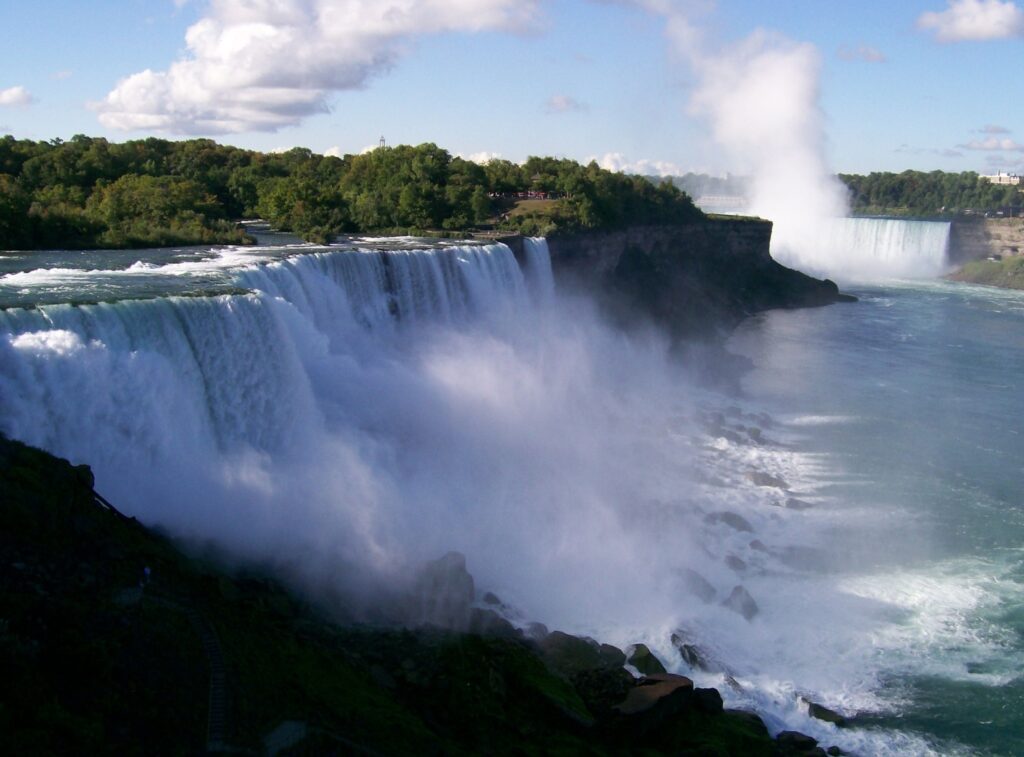These four lakes are composed of one fifth of all the fresh water in the world. They drain a very wide watershed with voluminous rivers that contain approximately 35,000 islands. They combine and race to become the Niagara Falls, which flow into Lake Ontario; and from there, the water flows as the St. Lawrence River, which eventually reaches the Atlantic Ocean.
The five Great Lakes have long been called inland seas and their surface area combined, is roughly equal to the size of the U.K. They are the largest group of freshwater lakes on Earth, containing 21% of the world’s surface fresh water by volume. Lake Superior is the second-largest freshwater lake in the world, and lake Huron is the fourth. Lake Victoria, shared by Uganda and Tanzania in Africa is number three, and the Caspian Sea in Russia is number one. Lake Michigan is the largest lake that is entirely within one country.
Then there is Niagara Falls. It is not just any waterfall, pouring spring rains down into a gully. It is more than an inundation of creeks and streams. It is an elemental outpouring of such rapid force that the very air has hardly time to get out of the way. The Falls are composed of three wide cliffs: American Falls, Bridal Veil Falls, and Canada’s Horseshoe Falls. They each drop seventy feet to the ancient hard rock of dolostone and shale. American Falls and Bridal Falls are separated by small Luna Island. The water’s rapid rush, pushing toward the drop is unexpected. The force at which they fall is over-powering, and the sheer amount of water is almost unfathomable. Combined, the two drop 150,000 gallons of water every second, but Horseshoe Falls drops 600,000 gallons every second. The three Niagara Falls are not just cascades of water. And I’m not talking about just any river that meets any ocean. This is the LARGEST amount of rushing and gushing water that falls off the earth.
I stood at the railing next to the river across from our hotel, staring at the water’s movement. It was an overcast morning so the water looked like gray-green slate. The sight was captivating. The water moved so quickly that it rushed by in flooding torrents. Churning in its frothy whiteness it would hit a rock, fly up and then tumble hard onto another rushing swell. Then I walked to the Falls and again became completely absorbed by its power. The sound was so thunderous, reverberating across the canyon, that I was hypnotized. The surging forces kept pouring over themselves, each shower a monsoon, each outpouring downpour an explosion. It was a series of colossal cataracts plunging furiously in a deluge of dominance and dominion. It was more than a driving, drenching rain. The whitewater spray was a violent flow that collided into cloudbursts, and formed its own atmosphere. Like a pot of boiling water when steam rises, misty clouds formed above the spray, and then surprisingly, gently floated off into the sky. How something so violent could turn into something so placid so quickly was astonishing.
We had planned that morning to go on the Maid in the Mist boat trip to get closer to the Falls at its base, but the day turned cold, rainy and windy. We decided that what we had seen was powerful enough. Later that evening, the rain subsided, so we walked back to the Falls to watch the nightly fireworks at 10:00 p.m. We dressed warmly against the wind and stood once more against the railing to see the fiery colors explode in the sky. Though the presentation was well done, and it helped to celebrate our visit, it was only a distraction from the immensity and profound power of the Falls below, presenting their own show.


 The official website of Lita-Luise Chappell, writer on sex, magic, food, distant lands, and everyday life with articles, poetry, novels, travelogues, rituals, cookbooks, and short-stories.
The official website of Lita-Luise Chappell, writer on sex, magic, food, distant lands, and everyday life with articles, poetry, novels, travelogues, rituals, cookbooks, and short-stories.
